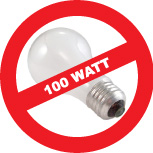THE URBAN HOME & GARDEN
New California light bulb law in effect

The new law requires that all bulbs manufactured after 2010 must be 25 to 30 percent more energy efficient. Retailers are allowed to sell out their existing stock of light bulbs produced before this year, and incandescent bulbs are not banned entirely, just the inefficient styles.
An incandescent bulb basically uses the same Victorian-era technology as when Thomas Edison invented it 125 years ago. Probably no other gadget we now use in modern-day life relies on such outdated technology. Can you imagine still using your first mobile phone or computer today?
Up to 90 percent of electricity used by an incandescent light bulb is consumed as heat. It’s estimated that there are over four billion screw-based light sockets in the United States and currently three billion of these still contain energy-wasting incandescent bulbs.
The 100-watt incandescent bulb is the first to be affected by the new law. The same amount of light produced by a 100-watt bulb, which is 1,500 to 1,700 lumens, must now be generated using 72 watts or less. The 75-watt, 60-watt and 40-watt incandescent bulbs will be affected beginning next year. Consumers have a wide variety of Energy Saving light bulbs to choose from as replacements, including compact fluorescent light bulbs (CFLs), light-emitting diodes (LEDs), and many new halogen bulbs now on the market.
CFL Bulbs
Among the commonly available types of bulbs, CFLs provide economical and energy efficient lighting. A fluorescent bulb produces light when electricity arcs between electrodes at both ends of a glass tube filled with low-pressure mercury vapor and other gases. Electrons flowing between the electrodes collide with vaporized mercury atoms, causing the mercury to release ultraviolet energy. A phosphor coating inside the tube absorbs the UV energy, causing the coating to emit visible light.
CFLs use about one-fourth the power of incandescent bulbs to produce the same amount of light, and while an incandescent bulb lasts about 1,000 hours, CFLs last approximately 10,000 hours. Over the life of a single compact fluorescent bulb, you will realize a savings of as much as $200 over the cost of an incandescent bulb. In recent years, the cost of CFLs has come down dramatically. Multiply all the sockets in your house times $200, and you’ll start to comprehend the savings you will realize by switching over to compact fluorescent lighting.
It’s important to remember that CFLs contain a very small amount of mercury – usually two to five milligrams. Consider that an older thermometer contains about 500 milligrams of mercury. Nonetheless, CFLs must be recycled and not thrown in the regular trash. Most independent hardware stores in the City are a part of the Department of Environment’s recycling program.
LED Lights
They may appear to be bulbs, but light-emitting diodes are actually tiny semiconductors. When power is applied, they are stimulated by the movement of electrons, thus creating photons, or light that is visible to the human eye. Because LEDs do not use filaments like incandescent bulbs, they emit much less heat and are more efficient in consumption and output.
Unlike incandescent lights, LEDs are built inside solid protective cases, making them extremely durable.
LED lights are becoming more commonplace in everyday applications and are used in traffic and signal lights, as status indicators on electronic equipment, in exit signs, and in emergency vehicle lights.
Halogen Bulbs
Halogen lighting design is a somewhat more energy efficient variation on incandescent technology. The sealed bulb contains a tightly coiled tungsten filament surrounded by halogen gas. During use, halogen combines with evaporating tungsten, redepositing tungsten on the filament, thus slowing down the rate at which the filament breaks down. Light output levels over the life of the bulb do not diminish as noticeably as with standard incandescent bulbs.
The light produced by halogen bulbs is whiter than standard incandescent, making colors appear brighter and more intense. Halogen bulbs are commonly used in the home environment for track lighting, accents, torchiere lamps, and recessed lighting.
While the costs of these new-technology bulbs are generally higher than traditional incandescent bulbs, costs have decreased dramatically over the last few years and the price can be recouped over the lifespan of the bulb.
I hope that this has been enlightening for both you and your home!
Julia Strzesieski is the marketing coordinator at Cole Hardware and can be reached at [email protected].


